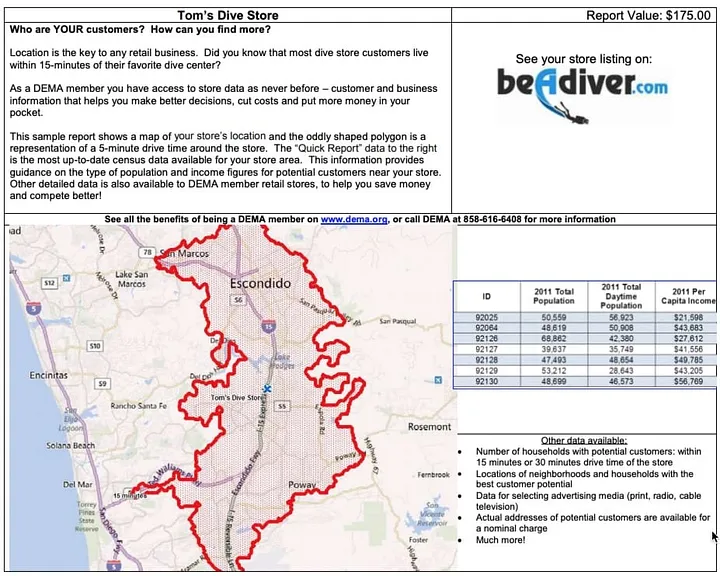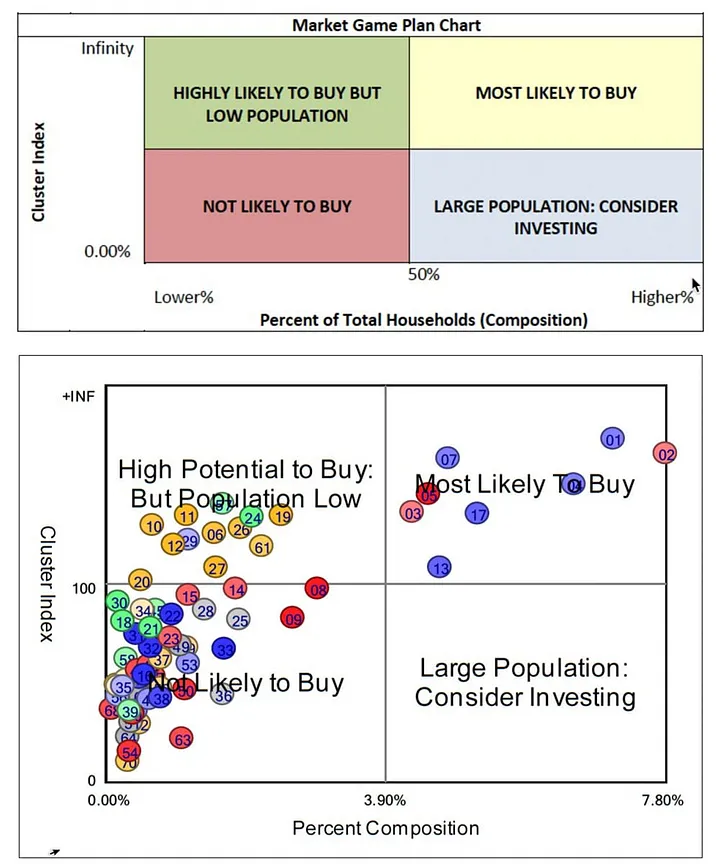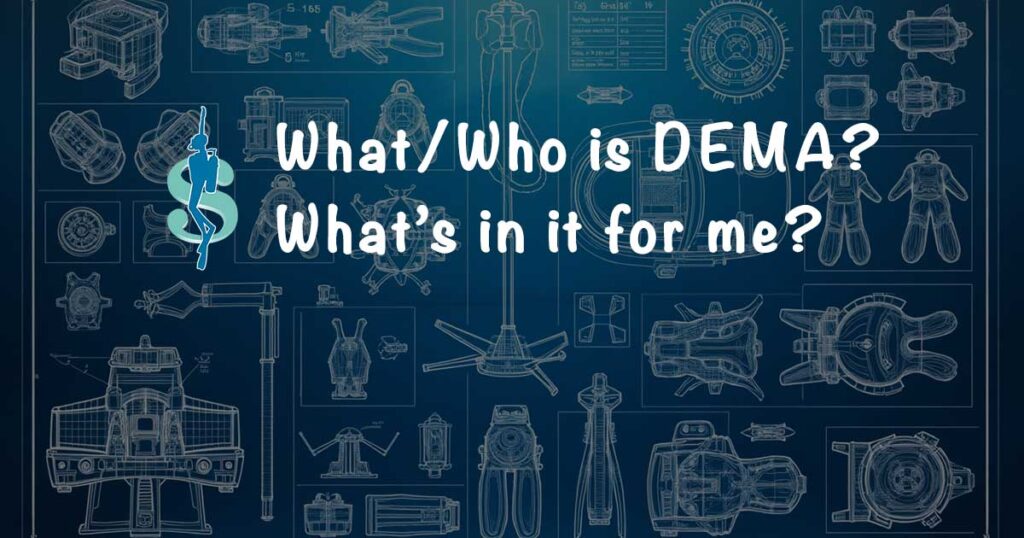What is the Diving Equipment & Marketing Association (DEMA)? Who is DEMA? What’s in it for me?
DEMA Board of Directors, Financials, PADI’s Influence, Services Offered by the Diving Equipment & Marketing Association (DEMA)
When you say “DEMA”, many dive industry professionals think only of the DEMA Show. But DEMA is more than just the DEMA Show.
DEMA is the Diving Equipment & Marketing Association. It was born under a different name. Initially, it was created by dive manufacturers, and the acronym meant Diving Equipment Manufacturer Association. Later on, manufacturers agreed to expand the role of the association and include the other dive industry stakeholder groups.
DEMA is located in San Diego, California. It claims to be an international association. However, it is significantly more active in the USA than anywhere else (on legislative issues, for instance). Some of its services are only available to its members in the USA.
Before we discuss the services offered by DEMA, let’s have a look at its structure.
This post is part of our Shifting Tides: Dive Industry Assessment & Strategies for Today’s Scuba Divers series by the Business of Diving Institute and Darcy Kieran, author of:
Table of Contents
The DEMA Board of Directors
This is, regularly, a hot topic in the dive industry.
The DEMA Board of Directors is composed of 2 elected representatives from 5 different categories, for a total of 10 board members. The groups are as follows.
- A1 — Manufacturer
- A2 — Training Agencies
- A3 — Dive Publishing, Media, Consulting and Non-Retail Service Providers
- A4 — Retailers
- A5 — Travel & Resorts
A4 & A5 represent, for the most part, the two different types of dive centers we’ve defined, with a twist. Retailers (A4) are what we called the “Origin Dive Centers” or “Local Dive Shops.” Our “Destination Dive Centers” are in A5, whether it’s a liveaboard or a land-based dive resort. For DEMA though, travel agencies specialized in scuba diving are also in A5.
DEMA Board Elections
To elect members to the board, every DEMA member (in any of the 5 categories listed above) is allowed to vote. However, not all votes are equal. In each category, there are three levels of membership fees that come with a different amount of votes.
- Silver: 1 vote. Annual membership $200.
- Gold: 5 votes. Annual membership $525.
- Platinum: 25 votes. Annual membership $2525.
DEMA collects about $330K annually in membership fees.
Many people in the dive industry complain about DEMA, but when the time to vote comes, only a handful of members bother doing it. For instance, in 2015, only 141 companies sent a proper ballot in; in 2018, it was 135.
PADI’s Influence on the DEMA Board
This is another hot topic. The DEMA Board is often accused of being an extension of PADI.
There are a bunch of reasons why PADI has an influence on who gets elected to the DEMA Board and on the decisions taken by the DEMA Board of Directors.
The Number 1 reason PADI has an outsized influence on the election to the DEMA Board: PADI actually votes!
Another reason, linked to this first one, is the number of votes PADI has. The word on the street is that each different PADI company (Europe, Asia-Pacific, etc.) is a ‘platinum member.’ Therefore, PADI has numerous blocks of 25 votes. And since most other members don’t vote, PADI has, by default, a significant impact on the election results. The year I was elected to the DEMA Board, I dug into the number of votes. I estimated that at least half the registered votes came from PADI. Therefore, any candidate supported by PADI is the one who will get elected to the board of directors.
A 3rd reason is related to PADI being the largest training organization in the dive industry at the moment. Therefore, a majority of A4 and A5 members are PADI members and most likely vote for other PADI members.
Outside the retailers and resorts, quite a few companies running for election to the board are doing business with PADI in one form or another. For instance, Caradonna was handling PADI Travel online (until PADI acquired Diviac). Bonnier was publishing the PADI magazines (until June 2019 when PADI acquired all of Bonnier’s scuba diving publications). And so on. Obviously, the board members from Caradonna and Bonnier didn’t want to antagonize PADI by voting differently on board decisions.
Structural Issues with the DEMA Board of Directors
Regardless of who has more influence on the Board elections and the Board meetings, the structure of that Board becomes, nowadays, questionable.
There are five different categories of Board members, representing five different segments of the dive industry. It may sound like a happy family, but… A decision that would be good for a group can easily be wrong for another one.
When we discuss how to change the dive industry business model to be more adapted to today’s marketplace and customers’ expectations, we cannot count on DEMA to lead the way — simply because changes to the structure of the dive industry would have a much different impact on each segment. It’s like a gridlock during rush hour.
By the composition of the DEMA Board of Directors, DEMA is stuck in a perpetual status quo. We cannot expect DEMA to be a leader for change.
And it’s OK. DEMA is a trade association. It’s the companies in the dive industry that need to lead change.
What is the DEMA Show?
The DEMA Show is an annual trade-only event for the dive industry. It is not open to the public. It rotates between Orlando (Florida), New Orleans (Louisiana), and Las Vegas (Nevada).T
The value of the DEMA Show varies among exhibitors and participants. Business representatives and dive professionals come to the show with their own set of goals and establish their own standards to measure success. Therefore, there cannot be a general answer to the question of whether the DEMA Show is “worth it.”
On the social front, it is an outstanding occasion to hook up with scuba diving industry colleagues from around the world. There’s no question about it!
However, on the business front, there could be better ways to provide more value to dive professionals. At the DEMA Show, we look at our own belly button – the same one, year after year.
If, on the other hand, scuba diving was a pavilion inside the gigantic Outdoor Retailer Show in Salt Lake City, we would find numerous benefits absent at the DEMA Show.
- By simply being part of a tradeshow with organizations that have reached a level of professionalism invisible in the dive industry, we would be dragged forward (and out of the stone ages).
- Attendees would find business ideas in exhibits by businesses operating in other outdoor activities.
- Companies involved in other activities may take an interest in scuba diving. After all, Apple has even taken an interest in scuba diving with its Ultra watch.
And the list of benefits goes on. In fact, I don’t see any valid reason to continue to do our tiny tradeshow in our little corner of the sandbox as if we were afraid to realize the world has evolved around us.
Why are we hellbent on living in the past?
DEMA’s Financials
If you are a DEMA member and you bother asking for (and looking at) the financial results, you will find that DEMA lives on the DEMA Show profits.
Here are some ballpark figures.
- The DEMA Show profits account for about 75% of DEMA’s revenues.
- Membership fees provide less than 20% of DEMA’s revenues.
- More than 60% of DEMA’s operating expenses are allocated to salaries and payroll expenses.
- Of the money spent by DEMA (excluding the tradeshow expenses), about 40% goes to ‘programs’ to help the industry like the ‘Pool Tour’ and the ‘Go Dive Now’ promotion.
Don’t you find it disproportionate that the majority of money we manage to raise for our dive industry trade association goes to salaries?
Perhaps we should also consider joining the Outdoor Industry Association to get more mileage out of our dollars.
Services Offered by DEMA
We’ll look, first, at what we consider the two most valuable services offered by DEMA.
Socio-Demographic Profiles & The Quest for New Customers
This is an outstanding service offered to dive shops in the USA. If you haven’t taken advantage of it yet… What are you waiting for?
It comes in 2 parts:
- The first part is about understanding the population within a short driving distance of your dive shop.
- The second part is about analyzing your current customers to determine their socio-demographic profile.
For the first part, here is a map showing an area within a 5-minute drive to a fictitious Tom’s Dive Store:

Five minutes is a bit restrictive. We suggest you work with a 15-minute or 30-minute drive time to your dive shop. However, this is an arbitrary statement. In reality, the distance people are willing to drive to get to you will depend on whether they want to buy a scuba diving course at that location or dive gear. We discuss the significant differences in the way people shop for dive training compared to scuba equipment in a post about The Octopus Strategy.
Beyond the driving-distance map, DEMA can provide you with a truckload of valuable information to help you identify and reach target clients in the zone around your dive shop. You could even get addresses of potential customers within the red area of that map (for an additional fee).
And the beauty of this service is that you only need to provide DEMA with your physical address. Therefore, you could also use this service to analyze neighborhoods where you are thinking about opening a dive center. It would help you pick the location with the best target market.
The second part of this service offered by DEMA is about analyzing your current customers.
This service helps you understand where your customers are coming from, and what is their socio-demographic profile. For this report, you need to provide DEMA with a list of your current customers, with addresses.
For the report to be useful, you need to have a fair size sample. If you only have three clients with an address in your database, then, obviously, the analysis wouldn’t provide anything useful.
You’ll get quite a few things back.
First, you’ll get a map with a red dot identifying the location of each one of your past clients who were included in the dataset you sent to DEMA.
Then, you’ll get something useful to market to similar clients, a Market Game Plan graph. It will look like this:

In this fictional case, your best target clusters (socio-demographic profiles) are 02 (Establish Elite) and 01 (Summit Estates).
DEMA will provide you with a full socio-demographic profile of the clusters you want to target, including:
- Age
- Household Income
- Estimated Net Worth
- Where They Live
- Length of Residence
- Marital Status
- Presence and Age of Children
- How many people in the household?
- Home Ownership Status
- Dwelling Unit Size
- Market Value of Home
- Occupation
- Education
- Ethnicity
- Buy Online?
- Buying Channels Preferences
- Magazines They Read
- Radio & TV They Listen To
- Activities They Do
If you have a large enough database, you could do this analysis for different types of products and services you sell. For instance, you could analyze your past clients who purchase scuba diving training courses. Then run another analysis for those who purchased regulators. There’s no limit to it, as long as you provide DEMA with a statistically significant sample.
To get more in-depth explanations of this service and why it is highly valuable to you, we strongly suggest you read the Prospecting for Customers in the New Normal article published in the now-defunct Dive Center Magazine.
Important marketing note: Using this service for marketing planning means that you will be working on recruiting clients with the same profile as your past clients. It makes sense in the short term, especially if you urgently need to increase your revenues. However, in the long run, what we need to do, as an industry, is identify the profile of non-divers who could become scuba divers if we were to redesign the way we deliver products and services.
Legislative Monitoring & Actions
This is not a service that you receive directly from DEMA. It’s something DEMA does for the industry — and it does it reasonably well.
Have a look at the Public Policy tab on the DEMA website. The legislative committee is quite active, and many of the issues and policies it tackles could have a significant impact on your business.
It’s worth being a member of DEMA even if it’s just to support this committee!
I still have a word of caution here. The dive industry is relatively small, and DEMA is a small industry association compared to so many other associations. Therefore, it is possible that in some cases, we would have a more significant impact by joining forces with other associations like the Outdoor Industry Association (OIA). They are incredibly active on this front. Just have a look at OIA’s Policy Agenda.
Other Services Provided by DEMA
There are other services offered to you by DEMA, including some dive industry data to help you with your business and marketing planning.
Consult the DEMA website, especially the content of the “Benefits” tab, and join. And vote!
Continue reading about Shifting Tides: Scuba Diving Industry Assessment & Strategies for Today’s Scuba Divers.
If you found the information on this page valuable, would you consider buying me a coffee?
Either way, let’s work together on “raising the bar” in the dive industry to satisfy today’s consumers!
Your Dive Industry Compass
Scuba Diving Market Research, Surveys, Reports & Statistics
Shifting Tides
Strategies for Today’s Scuba Divers
Living The Scuba Dream
Plan Your Scuba Instructor Career & Deep Dive the Plan
You may also be interested in The Immersion Zone (our podcast), Scubanomics (our newsletter for dive professionals), and our published books & reference guides.





